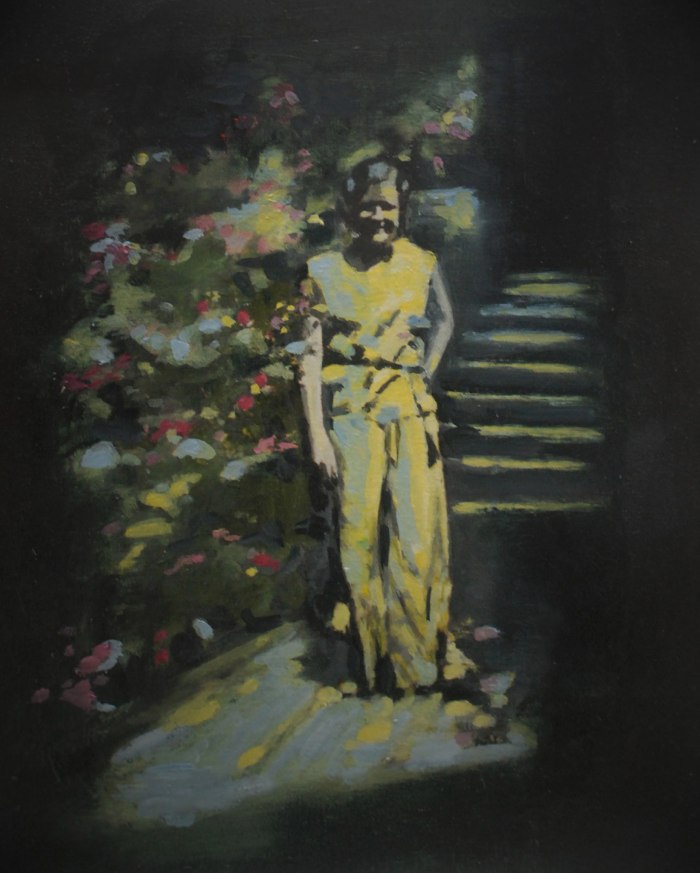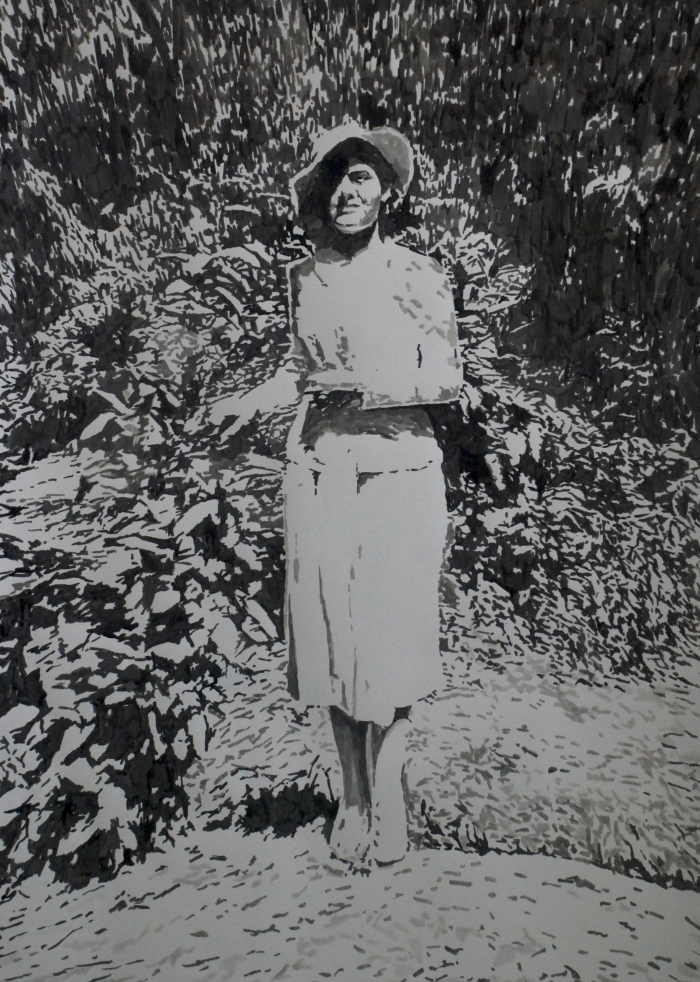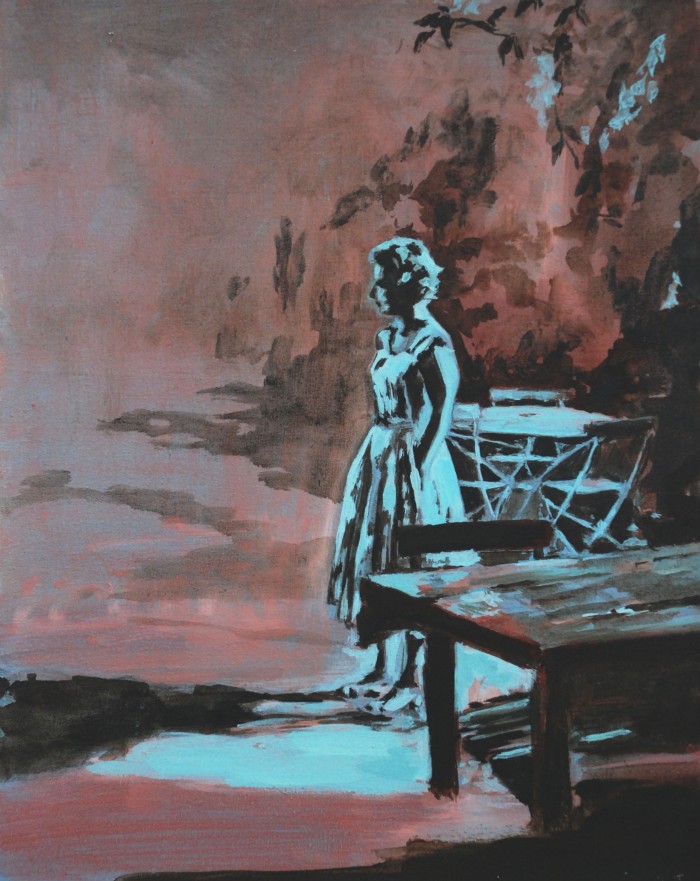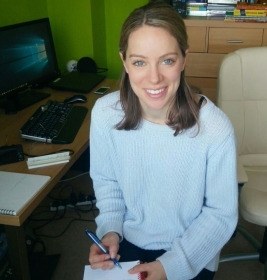The anonymous holiday snaps of a whole generation are finding a new audience through the work of artist Annette Pugh.
Art historian and blogger RUTH MILLINGTON explores how photographs found in charity shops and flea markets are being reinterpreted to create art playing with place, time and narrative…
“I wondered why it was that places are so much lovelier when one is alone”
Daphne Du Maurier, ‘Rebecca’
Annette Pugh paints the places she visited as a child: the pleasure gardens of Somerset; the holiday camps and coastline of Devon; the English Riviera.
Encapsulating the typical haunts of the British working class, she creates both a personal and collective memory, invoking in viewers a sense that they too once went ‘somewhere like that.’

Her paintings and large-scale drawings, defined by rich foliage, palm trees and light, are not what they first appear to be. Ostensibly exotic, her landscapes are, in fact, British places that have been ‘a little bit forgotten’.
Annette Pugh is one of a number of contemporary artists who assimilate archival material into their practice, projecting and up-scaling found photographs into her oil paintings and descriptive ink drawings.
Whilst she uses some personal family archives, most are discovered in flea markets or charity shops in the Midlands. She is particularly interested in amateur photography from the 1950s and 1960s; the figures in many of her canvases could originate from any number of working class family albums from this period.
‘The Fence’ features a formally-dressed couple seated side-by-side on grass in a park, a bandstand behind. This intimate, in-between moment seems startlingly familiar, representing a past era.

The artist’s interest in photography comes, in part, from her MA in Art and Design Histories at the University of Central England, during which she examined the use of the digital in fine art, and particularly painting.
Pugh cleverly alludes to, and incorporates, the nostalgic quality of historic photographs in her practice.
In her large painting ‘The Muses’ muted orange and golden tones give way to a blurred, dissipating vignette which frames four tall and delicately drawn palm trees.

There is also a digital quality to the impressionistic patterns of the black and white foliage cast across the ink-drawn image ‘Indian Summer’.
The artist painstakingly painted this work with a fine brush in just two sittings.
In his 2004 essay The Archival Impulse art historian Hal Foster defines archival art as a genre that makes ‘historical information, often lost or displaced, physically present’.

Pugh, beyond bringing archives into the present, also investigates the point at which the photograph becomes ‘more than just a copy’. She deliberately displaces it within mystical settings and what she refers to as ‘uncertain moments’.
Her imagined narratives show an artist frequently altering the found archive imagery which she reuses. Often, she will separate women from the group compositions of the original image, isolating them, and has said:
‘I do change the found imagery quite a lot…I like lone women, I think they are fascinating’.
Many of her solitary women protagonists embody an aura of romanticism. Particularly striking is ‘In the Pale Blue Light’: the female form, sheltered by large, hanging trees, is poised elegantly beside a full rose bush. With hands enclosed in the pockets of her narrow-waisted skirt, painted in an intense cornflower blue, she looks contemplatively into the grounds beyond the frame of the image.

There is a disquieting sense that all is not as it first seems, recalling Daphne Du Maurier’s gothic tale of Manderley. As in Du Maurier’s fiction, which Pugh enjoys reading, the artist’s female characters find themselves in places infused with memories and mysterious atmospheres which border on threatening.
Annette Pugh’s paintings tell of a journey into place and memory.
Her images invoke in the viewer a question about what makes memory, particularly in a post-photographic world. The artist shows how subjective recollection is entangled with visual imagery, created by both the camera and the artist’s hand.
This emotive series also shows memory to be both personal and universal, stored and recalled as fragments in the individual and collective consciousness. As the artist so eloquently says, these images are about capturing and constructing:
‘memory or moments that feel familiar to an audience, rather than being anyone’s particular history’.
By Ruth Millington
Biography

Ruth Millington is an art historian, arts writer and blogger based in Birmingham. She specialises in modern and contemporary art, and during postgraduate study at the University of Oxford researched the influence of fairy tales on contemporary women artists including Paula Rego, Kiki Smith and Cindy Sherman.
She has had work featured in a variety of publications, from ArtsBrum to the Telegraph, and blogs about Birmingham-based artists and exhibitions on www.ruthmillington.com
Stunning artwork.
LikeLike
Gorgeous, isn’t it?
LikeLike